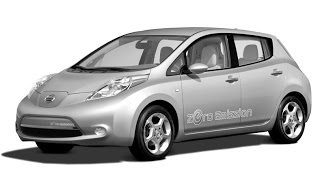Over the course of more than a hundred years, North American culture has adopted the notion that you can be anywhere on this continent in a matter of hours simply by turning the key. The all-electric Nissan LEAF brings about a flurry of technology and arrives at a time when governments the world over are attempting to kickstart electric transportation. But the LEAF expressly forbids you from travelling anywhere and everywhere. Instead, Nissan LEAFs (Leaves? LEAVEs?) force owners to accept the notion that what you’ll see in the next 75 miles (120 km) is… enough. Furthermore, the 2011 Nissan LEAF can’t go as far in cold weather and its range will be severely curtailed if you’re giving the go-pedal an extra workout.
This should be okay with us, we’re told. Our gasoline-powered cars offer limited range of motion, too. But when we stop, we need only stop for a few minutes. Nissan LEAF owners will require somewhere between 7-20 hours unless they shell out for a home charger which, remember, will only work at home. Nissan is trying to tell us that 70% of people drive less than 40 miles per day. What Nissan should tell us, but fails to accurately make clear, is that most drives are shorter than 40 miles. C’mon, don’t the vast majority of car owners drive more than 75 miles in between potential charges with some frequency? The Tucson-to-Nogales drug run can’t even be completed in a morning drive.
Go ahead and strip the LEAF’s lack of drug-running capability from the proceedings. GoodCarBadCar.net’s case against the LEAF still includes its lamentable exterior design. The GM EV1 looked sort of awesome, remember? Why shouldn’t an unusual car look amazing? The 2011 Nissan LEAF is also tremendously overpriced for such a limited-use vehicle – those rebates won’t last forever (but may last until prices of high-tech pieces come down). The LEAF’s limitations are all the more frustrating because, in truth, the LEAF isn’t slow, boring, or found wanting inside. In fact, the technology represented by the Nissan LEAF is exciting. LEAFs lay out abundant evidence supporting a good future for electrified transportation: full torque from idle, cheap to fuel, less maintenance, amazingly quiet. An electric future is the kind of future GoodCarBadCar.net would be excited about.
Unfortunately, Nissan failed to execute on the electric car’s prospective greatness and produced the LEAF as an impressive theory gone awry. Like, where’s the progress, dude? The EV1 of the 90s was similarly quick, could be charged in a similar amount of time, and could travel a similar distance.
LEAF blowers point to its European Car Of The Year victory, but that was a joke. The Nissan LEAF shouldn’t be taken too seriously either; at least not yet. LEAF blowers also offer up an array of excuses on behalf of the LEAF’s limitations. Good vehicles, however, require no excuses.
Alternatives: Chevrolet Volt, Nissan Juke, Fiat 500, riding the Appaloosa
Base USD/CAD Price: $32,780 / est. $36,000 (excluding government rebates)
Improvements Required: It’s hard to say exactly what type of range improvement would make GoodCarBadCar.net happy. The more miles the merrier. Surely a revised exterior would be of assistance as would a lower price. That said, John Voelcker pointed out that, if you’re a Sony employee in California’s central valley, the Nissan LEAF could cost as little as $12,280. At that price, the LEAF approaches Good 12-levels of credibility.
Historical Signficance: As the first potentially mass-market electric car on sale in North America since the GM EV1 (Who Killed The Electric Car?), the LEAF is hugely significant. Nissan, however, timed the LEAF to go on sale with the 2011 Chevrolet Volt. This idea was either brilliant or terrible. We may not know the impact of the decision for a decade or more.











Unless this car appeals to the senior citizens who don't stray far from home, I can't imagine it's sales being high. The main thing that would cause people to buy the LEAF would be, in my opinion, to help their green image. Triple it's range and I might consider overlooking the ugliness.
your comments echo my thought when I started reading about this vehicle – just doesn't make a lot of sense in the real world. The Volt had the better idea.
rate the car please….. not how people will or will not use it. Stick to facts about the car for a well written article…. let us make our own decision about whether the car is right for us or not….. please just rate the car for what it is and leave the overblown "dude" and other stuff out of the article…. Thanks very much….
The Leaf may be a niche car, but the niche it actually rather substantial: those who drive less than 80-100 miles a day (80% of drivers), those who can afford 2 cars (they have a car they can drive hundreds of miles in a day, which is your main gripe), and those who care more about feel, response, high tech and performance over how they'll be looked at by passersby (unlike the apparently insecure author of this piece), those who care very much where their gas dollars are going (arming terrorists, smog pollution).
I have 2 Leafs because I loved the first one so much and my wife kept borrowing it. I also have other vehicles (including an expensive Italian sportscar that I rarely drive) and I enjoy driving the Leaf the most! It handles well, accelerates very well, but I love how silent it is most. It is the ultimate luxury to have a car be so quiet that you can easily converse with others or listen to music at highway speeds.
As for your claim that it looks bad, a) even if true, who cares? B) I think it's more embarrassing driving a red Ferrari because it's such an appearance of chest pumping.
I think the car looks high tech and aerodynamic and it is. It is also way roomier than the BMW 335i I used ton have. seats 5, enough headroom for a 7' guy.
That's my testimonial. And you can thank me when you drive behind me that my car isn't choking you with smoke.